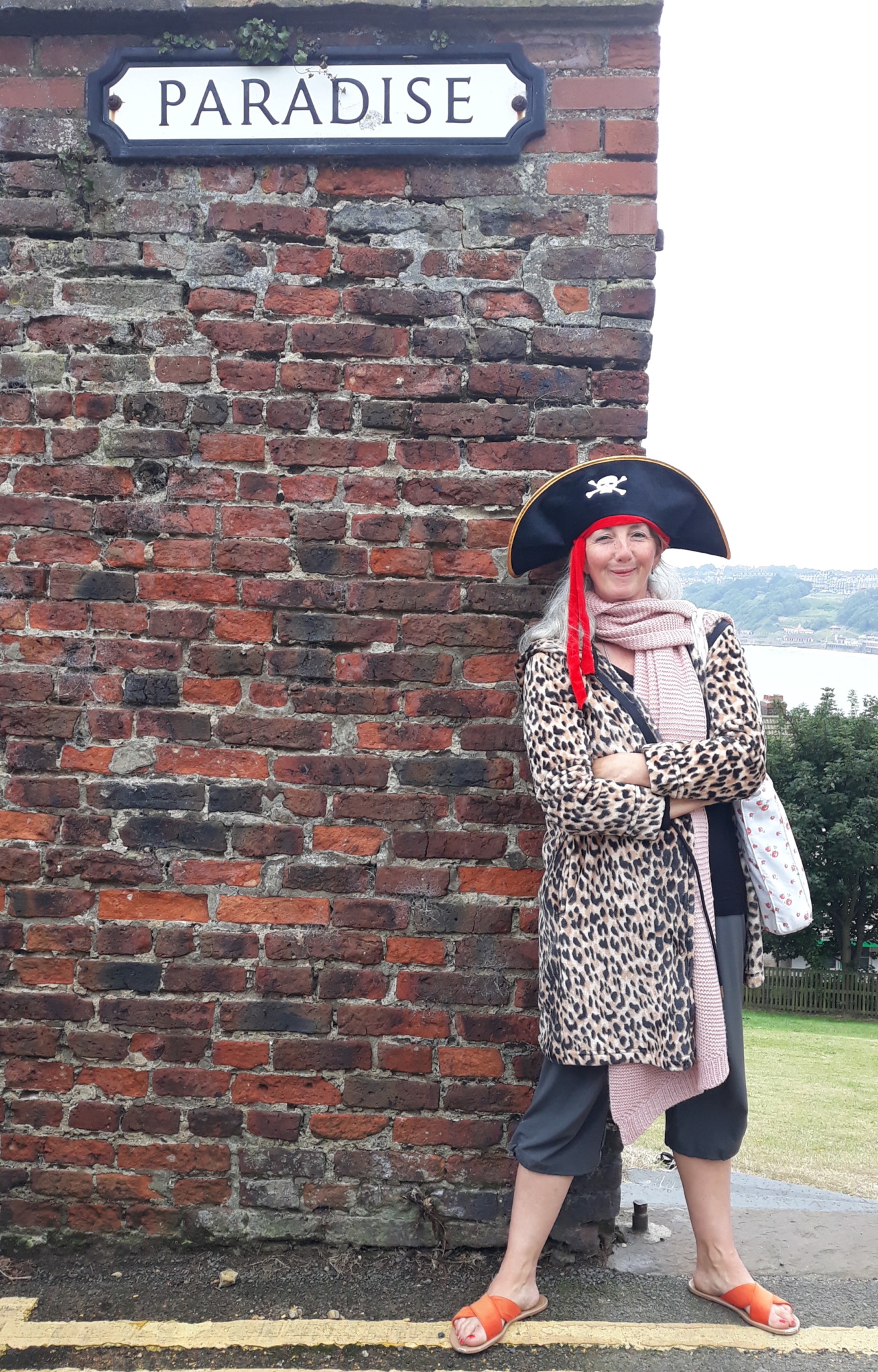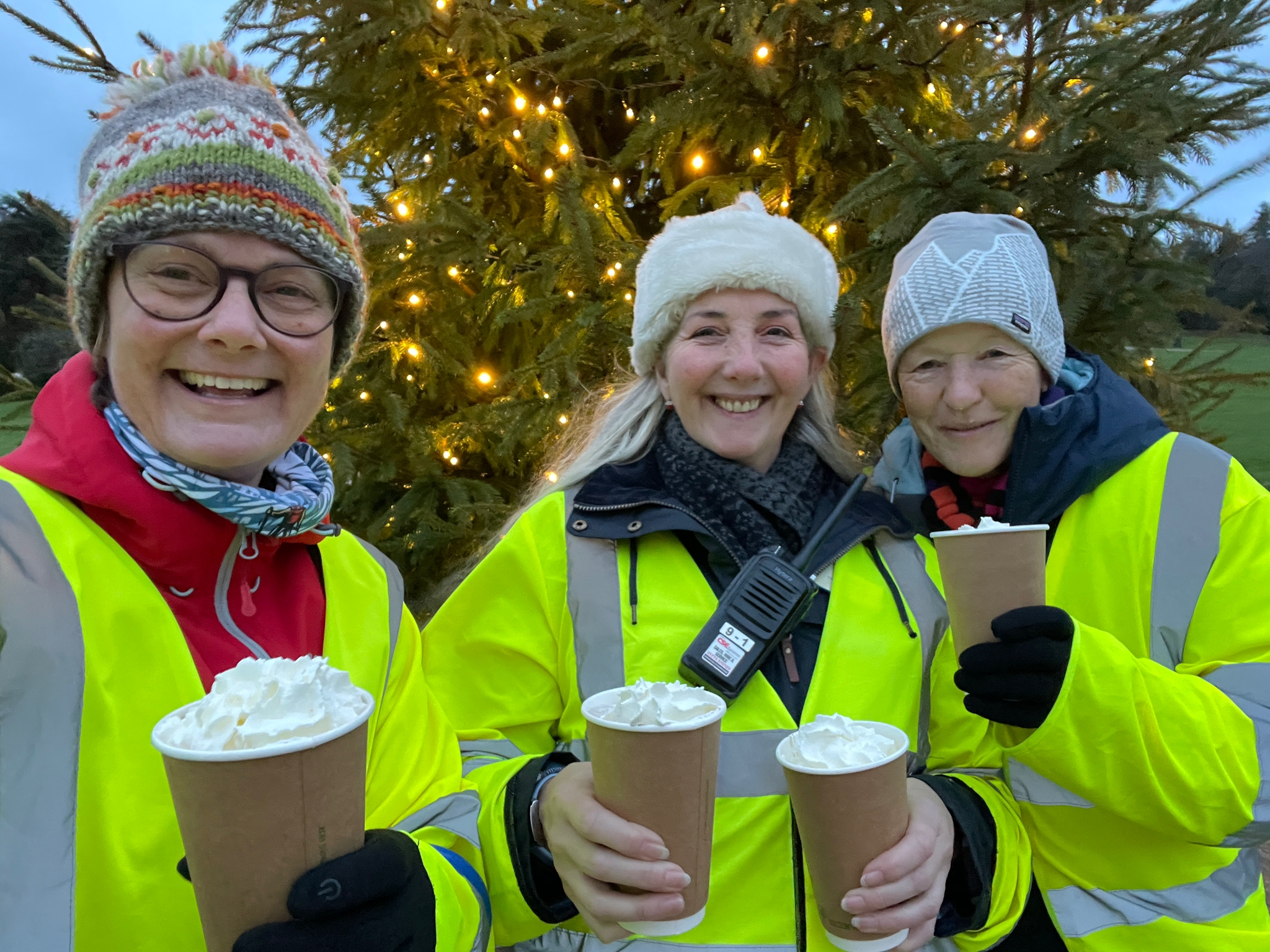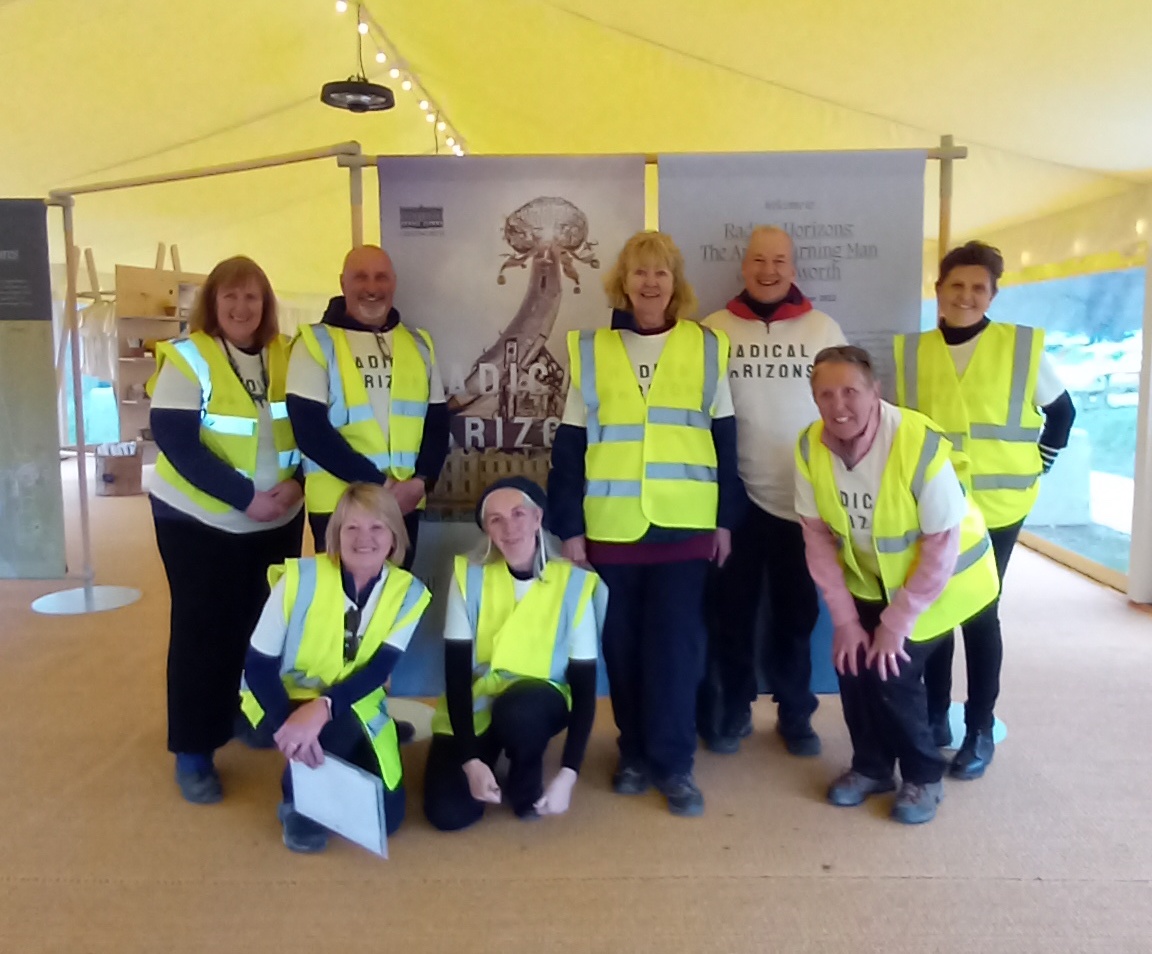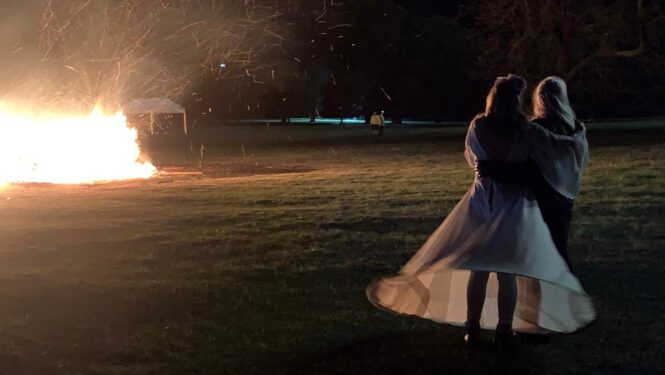In 2022 a unique project led by the team at the stately and oh-so-British Chatsworth House brought 12 monumental works of Burning Man art to the sedate, lulling landscape of Derbyshire. From April to October 2022, Radical Horizons: The Art of Burning Man at Chatsworth transformed Chatsworth’s 1,000-acre park into a surreal, all-ages fairytale playground with opportunities to explore, examine and question the meaning of art, creativity, collaboration and self-expression. Entrance to the park and access to the sculptures was completely free of charge and more than 500,000 people visited between early April when the exhibition opened and when it closed in early October with — what else, a burn and community celebration.
Read the rest of this three-part Chatsworth series here.
I had the absolute pleasure of attending the closing weekend, during which I met a host of wonderful characters who had helped make the project happen. In the days that followed, there was one person I kept thinking about again and again. Radical Horizons Volunteer Manager Marie Wood has a supremely warm spirit, and a way of speaking that immediately draws in her audience. She is kind, funny and insightful, and we were delighted that she agreed to chat with us so that we could learn more about her story and her role in bringing the art of Burning Man to the British countryside.
How did you get involved in this project, and what was your initial impression of Radical Horizons?

Marie: I was working as a storytelling performer, which is what I do as well as teaching. I was performing in a little venue in Sheffield, and this really lovely woman came up to me after the performance. It was a really dark February night and I was in this venue on my own with the guy from the venue stoking up the log burner. The weather was terrible and I thought nobody was going to come. In the end, 11 people came, and Nicky Crewe was one of them.
Sometimes you do a performance and it’s just a wonderful performance, and you really enjoy it yourself, almost as if you were watching it. It was a magical evening and it was an ancient story that I retold. At the end I got talking to this lovely woman and she was so fabulous. And I said, “What do you do?” And she said, “I work at Chatsworth.” And I said, “Oh really? It must be wonderful working at Chatsworth.” Chatsworth for a lot of people in Sheffield, including me, is a place where you took your kids when they were little to go to the adventure playground or go for a walk.
She said, “You should go on the website. They’ve always got jobs.” My teaching contract had come to an end so I thought I’d do something different. I just casually went on the website and there was this Visitor Supervisor job for Radical Horizons, the Art of Burning Man. I literally had no idea what it was but it sounded interesting. I’ve got one friend who’s a bit of a hipster and she knows about Burning Man. She said, “Oh my God, Burning Man, it’s really cool. It’s in the desert and blah, blah, blah.” She’s got friends who’ve been to Burning Man but they’re very sort of hip dudes. And I was like, wow, they go, it must be amazing.
I went to Chatsworth a couple of days later for an interview. They asked me a lot of questions about leadership style and things like that. And I said, “Well, my leadership style is go with.” If I’m going to recruit volunteers, I would be with them and I would work with them and alongside them and do things together. That would be my approach. Not sort of lead from behind or go marching ahead thinking I know it all, but be with the people who I’m working with and acknowledge their talents and let everything flow from the people who are there. And they were just like, “We really want you to work here. We want you to do this.” And, and I was like: what exactly is it?
I started seeing the sculptures arrive from America. Each day when I went in, there were more sculptures. I met Kye Horton. I absolutely love Kye. She is just beautiful. Bryony (from the amazing Visitor Experience Team at Chatsworth) and I sat with Kye and she told us the story of Burning Man. We loved it. And I just thought, wow, this is fantastic. I couldn’t believe that I was going to be part of it.
How did the 10 Principles shape your approach to the role?
I really wanted to make the training program really out there and wonderful, and base it on the principles of Burning Man that Kye had shared with me. I picked up those principles and embraced them fully — they were already dear to my heat from years of working with groups in similar ways. I absolutely love those principles. So the way we operate is going to be via those principles. We’re going to be Radically Self-reliant. We’re going to just allow ourselves to flow. We’re going to meet people, we’re going to expect a lot from them and we’ll share a lot with them. And we are not going to tell people what it is. We’re going to ask people: “What do you think? And what’s your experience?”
And it was so wonderful. The whole thing. I loved it. I mean, I absolutely loved it and everyone, all those volunteers loved it as well. It was inclusive, creative and — very importantly — it was free! The way it was for them was so different to what Chatsworth was normally for those who had worked there before. Chatsworth can be quite inflexible and formal, appealing to a certain clientele. But there was a lack of rigidity. They just loved it. They were so touched that they were being allowed to decide things and do things and it was wonderful.

For those who aren’t familiar, can you say a bit more about Chatsworth House?
Chatsworth House is a stately home in the countryside that’s been lived in by the same family for 15 generations. 400 years ago, a woman named Bess of Hardwick founded Chatsworth. She was a contemporary of Elizabeth the First. She made provisions for her family to live in that house for generations, and they literally still do. So it is an unusual place in terms of world heritage. It’s unusual for one family to remain in one domain for that long. The staff and volunteers who work there feel part of that family and the Duke and Duchess treat their people and visitors with respect and warmth, knowing that the house and grounds would not function without them. It is a beautiful house that is home to a national and internationally significant art and book collection.
It has gorgeous grounds with farmland and farming practices that have been going on for generations, including a deer park. It’s very traditional. It has events like a country fair and everybody comes in their hunting and fishing gear, but it’s also a beloved place of people in the local area. It’s right on the edge of the steel-producing city of Sheffield, and that’s where people from Sheffield would go for weekends to get away from the grime of the city. There’s been an effort by Chatsworth to open it up to new visitors, to visitors who’ve not been there before, and to visitors from different cultural groups.
Can you talk about the engagement with local children and school groups during this project?
The Education team does a lot of work to try and reach out to different people. I came from inner city Sheffield, working in a school in a very tough area with quite a lot of kids who’ve never seen a cow. One of the things that I was really happy about was that I was able to get those kids to connect with the Education team and they came to Chatsworth. They were there on the burn night and had made lanterns with the Education department at Chatsworth, and that was so good.
This was organized with Mums United group who came from Sheffield. I met them about a year and a half ago. They are organized by a beautiful group of women held together by Sahira Irshad. She’s gathered together a group of moms from all over Sheffield, from lots of different religious and cultural groups. She’s bringing them together in a beautiful way to provide different things for the young people in their care. That’s her big crusade and she’s absolutely brilliant at it.
Can you tell me about your early memories of your relationship with creativity? How did you tap into your own creative energy?
 I grew up in quite a rough estate in Sheffield, but I loved theater. I had a drama teacher who one day gave me a leaflet for Sheffield Youth Theater and she said, you should go to this. So in between fights and having smokes behind the bike sheds and the usual activities of Sheffield I did that day, I decided to go to this youth theater. I was only 11. It was two buses to get there across town, into town and then back out the other side. And when I got to this building, it was an old school building, a Victorian building with high ceilings and wooden floors and very old fashioned.
I grew up in quite a rough estate in Sheffield, but I loved theater. I had a drama teacher who one day gave me a leaflet for Sheffield Youth Theater and she said, you should go to this. So in between fights and having smokes behind the bike sheds and the usual activities of Sheffield I did that day, I decided to go to this youth theater. I was only 11. It was two buses to get there across town, into town and then back out the other side. And when I got to this building, it was an old school building, a Victorian building with high ceilings and wooden floors and very old fashioned.
When I went in through the doors, the whole of the floor in front of me, a big vast hall, had been visquined off with heavy-duty plastic. They’d covered the whole floor with heavy duty blue plastic and then filled it with sand. And on the sand were all these pieces of driftwood and giant shells and pieces of coral. And they’d built this kind of island environment with big trees and branches and old crates and bottles and a place where a shipwreck might have happened on an island. And we were all just encouraged not to talk, but to just take our shoes and socks off and walk out onto this island. I mean, it’s so Burning Man, actually, isn’t it?
So I walked out into that environment and then people started to speak a language and it was Shakespeare [The Tempest]. I’d never heard it ever before in my life, but that was it. I just loved it.
Be not afeard. The isle is full of noises,
Sounds, and sweet airs, that give delight and hurt not.
I heard these words that I just loved so much, and I went there every as often as I could for the rest of the time that I lived in Sheffield. Eventually I worked there. I became a director and artistic director. By the time I was 16, I was writing plays, I was involved in teaching little kids how to do plays. I did really badly in my own school because I just found it so tedious. I always used to argue with the teachers about Shakespeare and how exams are rubbish. Eventually I went to drama school in London and then I went to University College of London (UCL) and trained to be a teacher. I always carried on acting and doing theater projects and became Head of Drama in a school. Eventually I returned to UCL as a Freelance Teaching Fellow and have been freelance ever since.
How did you recruit, train and lead a group of volunteers for Radical Horizons?
Chatsworth was advertising the role and I was on the other end of the software for the recruitment process and everyone who expressed an interest, I just told them to come. So even if they could only do an hour a week or they felt like they might be on holiday for most of the event or anything, I just said, don’t worry, just come, it’ll be fine. If they were young, if they were old, male or female, whoever they were, I just said, come and it will be great. The inclusion banner was upmost in my mind, and always is.
I thought, whoever comes, they’ll be the right people. And people came.
The first big meeting we had was with Kye and she showed them some of the pieces from different events and we talked about Burning Man and what it might mean. The next time we met I got them to make a map of the event, but using expressions of appreciation instead of the names of the sculptures. I had them make a still image of the sculpture with a partner and everyone else had to guess what it was. Then they had to be the voice of the sculpture, and just lots and lots of imaginative things that brought it out of the box and stopped it from being just formulaic. “I’ve read the information and I know what everything is. And now I’m going to regurgitate that information.” We opened up to the point where every person who we met during the event, we would say, “What does it make you think of when you look at this sculpture?” And then you could support a conversation that led on from that. You could keep unraveling meaning.

Can you share a specific example?
I met Benjamin (Langholz of “Stone 29”) and that was really nice because he’s so very out there. He was so sweet and I really understood how he wanted his piece to be interpreted. We really tried to be faithful to that. At first people were like, “Oh, it’s the stones that wobble. Oh, be careful!” And he didn’t want people to see it like that. So we retrained ourselves and started getting people to stand on the ground and be really still, and then say when you get onto the stones, they are as safe as the ground you’ve just been standing on. So you can go on them right to the top and they’re still that safe. Go and see what happens. And then, you know, people would have a massive experience. One time everyone came off them, and we went and stood under the tree next to them and I said, so what happened?
And one said, “Oh my God, it was terrifying.” And someone said, “Oh, I didn’t think so. I just walked straight up and I just stood there and I felt really at ease.” And then someone said “I had to hold someone’s hand.” They all said different things. And I said, “So what does that tell you? You know, what is this piece about?” And they went, “Well I suppose it’s about life, isn’t it?” And I said, “Yeah, I can’t think of any better way to describe it.” It was just so lovely. “Yeah, it’s about life. Sometimes you need to reach out and hold a hand. Sometimes you can go right to the top on your own and you don’t need anyone. And other times you just don’t even go there at all. But it’s all okay. It’s all fine. That’s what life is. And different times you’ll be different. You’ll be a different person. You won’t always not be able to go to the top. In some places you’ll be able to do that. And in others you won’t. But that’s okay.”
Did your impressions of Burning Man change from the beginning to the end of the project?
I think one of the things I realized was that Burning Man is a bit like the blind man and the elephant. For some, Burning Man might be a little long thin thing with tassels on it. And that’s an elephant. And for another man, it’d be a big leathery place or a pointed ivory thing. They’re all touching the same object, but they’ve got no idea. They all think it’s something else. I just realized: oh my God, it’s absolutely massive. The amount of stuff that happens there. I suppose for me it was all about the principles, Temple Burn, the Man, the sculptures. But also I was realizing or kind of learning as I went along, it was this incredible gigantic sort of out-of-this-world event with 1,001 different things happening at it. And all of them were acceptable in their place and their time. And I found that so fascinating.
Is there a particular principle or aspect of Burning Man culture that resonates with you?
I like the way they’ve all evolved from necessity in a way. They all are significant, but I think the sense of creativity and community for me is the key factor. I feel that Burning Man is something that’s within each person. I had these scrolls made at the end of the event for the people who’d worked as volunteers and they had “Burning Man” written in Japanese, so you kind of unfold them and the letters were there because we had a Japanese group come one day to visit and one of the young ambassadors got them to write Burning Man, but not Burning Man as in the one that’s on fire, but Burning Man as in the one who’s burning with desire to create.
Everyone’s burning with a desire to express themselves in a beautiful way. The possibility to do that gives people so much joy, and so much access to their inner contentment. To be able to just express and be heard, be loved, be respected, be allowed to express themselves in whatever way is coming naturally from within them. That resonates with me.
What do you think Burning Man can offer the world right now? Why is it valuable?
Burning Man can offer vast possibilities. I think it can offer a great uplift of humanity, to join hands together and allow yourselves to just do something that you don’t normally do. Be creative, even if you never have been before. Meet people who you don’t know from Adam and just say, “Hey, should we do this thing together?” And just do it. Burning Man is there in every community. If it’s the analogy of a fire, there should be little fires breaking out everywhere, like beacons that send messages to one another across mountain ranges. It shouldn’t feel that you’ve got to go 8,000 miles to get somewhere to do it. You should feel that you can just say to your neighbors, “Should we build a thing?”
Shrine and all the other artists who came were so good at sharing. That’s one of the things I found so touching about everyone, Dana, Flash, Shrine, the guys who built “Lodestar.” Every single artist. I’m not going to name every artist who was there, but there isn’t a single one of them who wasn’t so benevolent and acknowledging that you were already as important a part of what they were doing as they themselves. I found that really refreshing and so touching. Sometimes when you meet people they’re just so carried away with their own ego that they don’t even notice the little people around them. These artists were just not like that. They were incredibly loving, super talented people who were just there to acknowledge the talent of others. I just found that so inspiring. It was lovely. Really lovely.
Are there any other insights about this experience that you’d like to share?
The volunteers who worked on this project left it feeling as if their lives had been completely transformed. They all spoke of it at the end. And that was very inspiring for me because it was a gathering where there was creativity, freedom, and acknowledgement of humanity, and of who you really are. The space was given for that freely. Those volunteers really went with it.
There’s Burning Man and then there’s what’s going out from it into the world. It’s like an epicenter where it’s attracted everyone in and then everybody goes back to where they came from. And it would be great if what evolved was a flowering that was very widespread. I feel very privileged and delighted that I’ve had a chance to be part of it and I definitely will champion it and I will keep sharing the things that I perceive to be the principles of it.
Is there anything you would like to share with me that I didn’t ask you about?
I hope every single person who got involved remembers the wonder and beauty of what they felt and knows that came from within them and is never absent.
I also think about Lord and Lady Burlington and what a great moment this is for them. As patrons of the arts, I know it was the Duke and the Duchess and Lord and Lady Burlington, all four of them who really must have been the permissive quality in the project. I think it’s so wonderful that they were, and I really hope that they take from it some inspiration to do more of the same.
Cover image of Marie Wood and Nicky Crewe watching the closing burn at Radical Horizons: The Art of Burning Man at Chatworth (Photo courtesy of Marie Wood)


Brilliant article.
It just shows how getting perceptions and ideas from different, non-playa sources can be so inspiring and rewarding…
Report comment
A wonderful write up of a fantastic project, Megan! It was an honour to meet Marie when I visited Chatsworth House during the exhibition last summer, and to be part of the closing weekend events too. I don’t think I’ve ever met someone who so naturally embodied the spirit of Burning Man without ever having been before! – Marie was the perfect person for this! Thank you Marie!
I also really hope Burning Man considers more link ups with different communities – like this project did. Having half a million people visit the exhibition was brilliant – I could see that the people who attended were, in the vast majority, not people who’d even heard of Burning Man before – so this provided a fantastic opportunity to bring Burning Man’s art and ethos to a brand new audience. Everyone I met there absolutely loved it!
Report comment
Comments are closed.